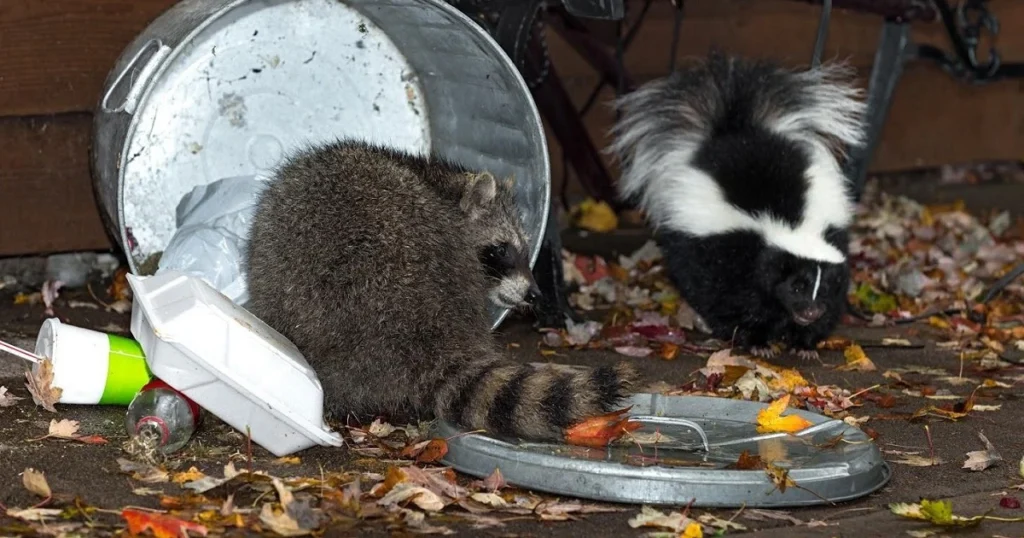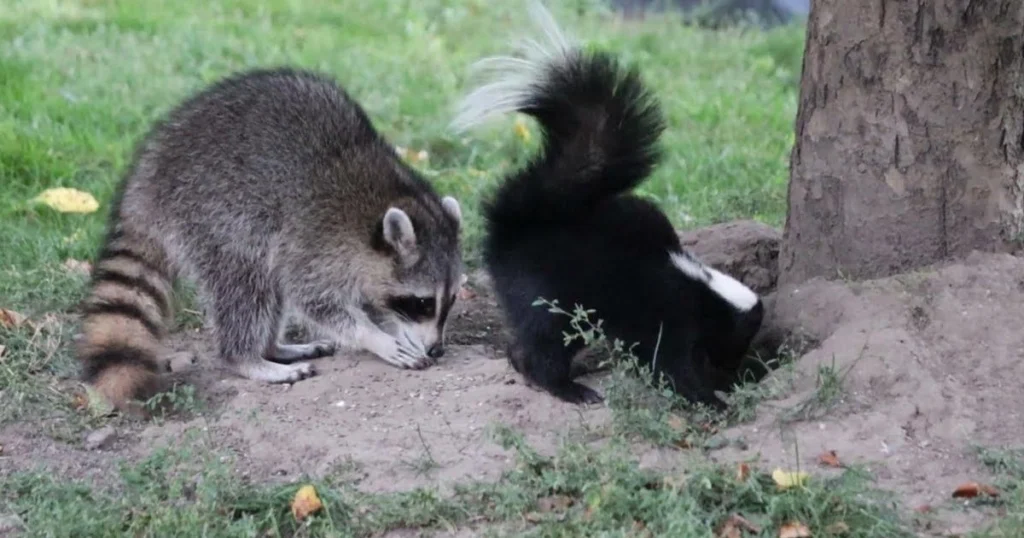
Their interactions can be quite intriguing when exploring the dynamics between skunks and raccoons. Generally, skunks and raccoons do not get along well due to their differing behaviors and territorial instincts. While both are nocturnal foragers, they often compete for similar food resources, leading to confrontations.
Skunks are known for their distinctive defensive behavior, which they use to protect their territory from other animals, including raccoons. Conversely, Raccoons are more curious and may sometimes approach skunks, but they can provoke a defensive response. Understanding these instincts can explain why these two species avoid each other.
Skunks typically keep their distance when they encounter each other in the wild. Their unique adaptations and survival strategies contribute to a clear boundary in their interactions, making it unlikely for them to form harmonious relationships.

Skunks and raccoons are both common wildlife species in North America. Despite their frequent cohabitation in urban and suburban areas, their interactions can be complex and influenced by their physical traits and behaviors.
Skunks are easily identifiable by their black fur and distinctive white stripes. These markings are not just for show; they serve as a warning to predators. Adult skunks typically weigh between 5 to 14 pounds and can measure about 20 to 30 inches long.
Raccoons have a more varied appearance, featuring grey fur, a masked face, and ringed tails. Adult raccoons usually weigh 8 to 24 pounds and can reach lengths of 24 to 38 inches. Their dexterous front paws allow them to manipulate objects and food effectively.
Both skunks and raccoons are adaptable and can thrive in various environments. Skunks prefer open fields, forests, and suburban neighborhoods where they can find food and shelter. They are primarily nocturnal, foraging at night for insects, fruits, and small animals.
Raccoons are highly versatile. They inhabit forests, urban areas, and wetlands, often seeking food in garbage cans or near water sources. Like skunks, they are nocturnal and are known for their social behavior, often living in small groups.
While they coexist in many regions, their interactions can vary from peaceful foraging in shared areas to territorial disputes over food sources.

Skunks and raccoons may share similar habitats, leading to various forms of interaction. Their behaviors and feeding habits can affect their coexistence in the wild.
Both skunks and raccoons thrive in urban and suburban environments, often utilizing gardens, parks, and wooded areas. They tend to be nocturnal, which can lead to overlapping activity periods.
These animals may navigate similar territories in residential areas, searching for shelter in dens, under decks, or in abandoned burrows. While both species are largely solitary, they can occasionally be seen in proximity without significant conflict.
Territorial disputes are rare due to their natural behaviors and abundant resources in shared habitats. However, the potential for competition exists, especially in areas where food sources are limited.
Skunks and raccoons have varied diets that sometimes overlap. Skunks primarily consume insects, small mammals, and plants, while raccoons are omnivorous, eating fruits, nuts, insects, and even scavenging leftovers from human waste.
While both animals may forage in the same areas, they often seek different food types, which can minimize direct competition. Raccoons are known for their dexterous paws, allowing them to access more diverse food sources, including those that require manipulation.
In contrast, skunks are less adept at scavenging from difficult locations. This difference enables them to coexist peacefully, as each species can find sufficient resources without engaging in significant competition.

Both skunks and raccoons use unique defense mechanisms and scent communication to navigate their environments. These adaptations help them deter predators and communicate with other individuals of their species while also influencing interactions.
Skunks are well-known for their potent spray as a primary defense mechanism. The spray contains sulfur-containing chemicals that produce a strong odor, deterring most potential threats. When a skunk feels threatened, it can accurately spray up to 10 feet.
The effectiveness of skunk spray is not only in its smell but also in its ability to linger. Residual scents can remain for days, marking territory and warning other animals. This spray is unique to skunks and is not something raccoons can produce. Raccoons can smell the lingering odor of skunk spray but do not possess a similar defensive mechanism.
Raccoons utilize various defense behaviors rather than relying solely on a chemical spray. Known for their inquisitive nature, raccoons are skilled at climbing and escaping threats. They might retreat to trees or dens when feeling threatened.
Additionally, raccoons can exhibit aggressive posturing, such as hissing or showing their teeth. They do not spray like skunks but can produce a mild musky scent when stressed. This scent is less intense or recognizable than skunk odor, leading to less effective communication about territory or danger.
Raccoons also depend on their adeptness at foraging and problem-solving to avoid confrontations rather than direct conflict.

Conservation and wildlife management efforts are crucial for maintaining balanced ecosystems. Understanding the interactions between species like skunks and raccoons aids in crafting effective management strategies.
Protecting both skunks and raccoons involves addressing habitat preservation and legal protections. Many regions have implemented wildlife protection laws to safeguard natural ecosystems where these animals thrive.
Conservation groups often research to monitor skunk and raccoon populations. This data informs policymakers about potential threats like habitat destruction and urbanization.
In addition, rehabilitation centers may help injured or orphaned individuals. These initiatives ensure healthy populations and promote genetic diversity, which is vital for their survival.
Community education plays a crucial role in coexisting with skunks and raccoons. Local organizations often hold workshops to inform residents about these species' behaviors and their ecological importance.
Moreover, cities may establish programs to promote wildlife-friendly practices, like proper waste disposal to reduce raccoon foraging. Encouraging natural barriers or wildlife corridors helps balance urban development and wildlife habitats.
Engaging the community creates a sense of responsibility and awareness. Citizens can participate in citizen science projects, reporting observations to aid research and promote conservation efforts.

Managing human interaction with skunks and raccoons is essential for pest control. Effective strategies help mitigate conflicts and reduce populations humanely. Understanding trapping methods and best practices can lead to better coexistence with wildlife.
To prevent skunks and raccoons from invading properties, homeowners should implement several best practices:
Utilizing repellents can also be helpful. Natural options include vinegar or citrus peels. For more persistent issues, consulting experts like Critter Stop is ideal. They have a fantastic reputation and customer reviews online because they provide high-quality work and great customer service. A professional inspection can help identify vulnerabilities.
When trapping raccoons, it is crucial to follow specific guidelines to avoid capturing skunks accidentally.
Check traps frequently to ensure their well-being. If a skunk is inadvertently trapped, do not confront it directly. Instead, contact a professional like Critter Stop at (214) 234-2616 for assistance. Their expertise ensures humane handling of wildlife removal.
When dealing with wildlife in your yard, it’s important to understand the behaviors and interactions of different animals. Skunks and raccoons are two common critters that may be sharing your property. In this FAQ section, we’ll address some common questions about their relationship, behaviors, and how to manage them effectively.
Skunks and raccoons can share the same territory without major conflicts. Although they are nocturnal and may compete for food, their interactions are generally peaceful. Skunks prefer to avoid confrontation, and raccoons, opportunistic feeders, are more interested in finding food than in picking fights with other animals.
Yes, raccoons and skunks can coexist peacefully in suburban areas. Both animals are adaptable and can live close to human populations, often finding shelter under decks, sheds, or in wooded areas. However, while they can live in proximity, it’s important to manage food sources and secure trash to prevent attracting large numbers of these animals to your property.
No, raccoons do not spray like skunks. Skunks have specialized glands that produce a strong-smelling spray used for defense. Conversely, Raccoons rely on their agility and climbing abilities to escape predators rather than using a defensive spray. However, raccoons can hiss, growl, and become aggressive if they feel cornered or threatened.
Raccoons might smell like skunks if they’ve encountered a skunk and been sprayed. This is not common but can happen if a raccoon inadvertently threatens a skunk or encroaches on its territory. The skunk's spray is very potent, and the smell can linger on the raccoon for some time.
Skunks are generally more solitary and less aggressive than raccoons. They move slowly and rely on their spray for protection. Raccoons, however, are more social and often seen in small family groups. They are also more curious and bold, especially when finding food. Understanding these differences can help you manage their presence on your property.
Skunks and raccoons are not closely related. Skunks belong to the family Mephitidae, while raccoons belong to the Procyonidae family. Despite sharing similar habitats and behaviors, they are different species with distinct biological traits and evolutionary histories.
To trap raccoons without catching skunks, use bait that is more appealing to raccoons, such as marshmallows, canned cat food, or sweet foods. Place the trap in areas frequented by raccoons, and check it frequently. If you accidentally catch a skunk, approach the trap slowly and cover it with a blanket to avoid alarming the skunk, which may cause it to spray.
Yes, it is relatively common to find skunks and raccoons living close to each other in the wild. Both species are adaptable and thrive in similar environments, such as wooded areas, suburban neighborhoods, and places with abundant food sources. While they may share the same general area, they typically avoid direct interaction.For more information on managing skunks and raccoons around your property, or for expert wildlife removal services, contact Critter Stop at (214) 234-2616. Our team is dedicated to humane and effective wildlife control, ensuring your property remains safe and pest-free.
Visit our Critter Library and learn more about our furry friends